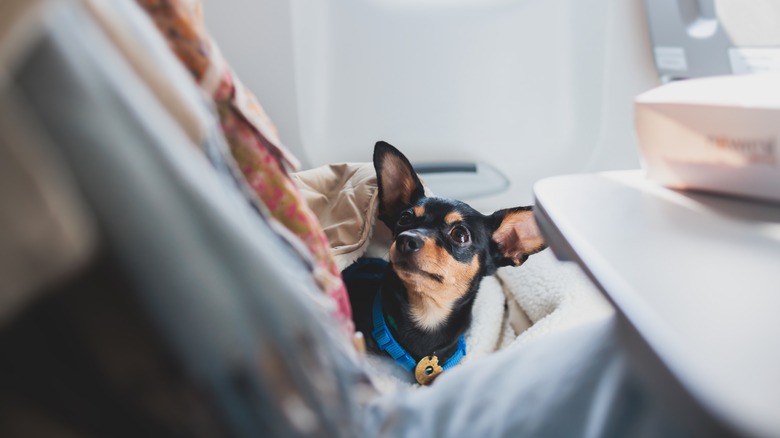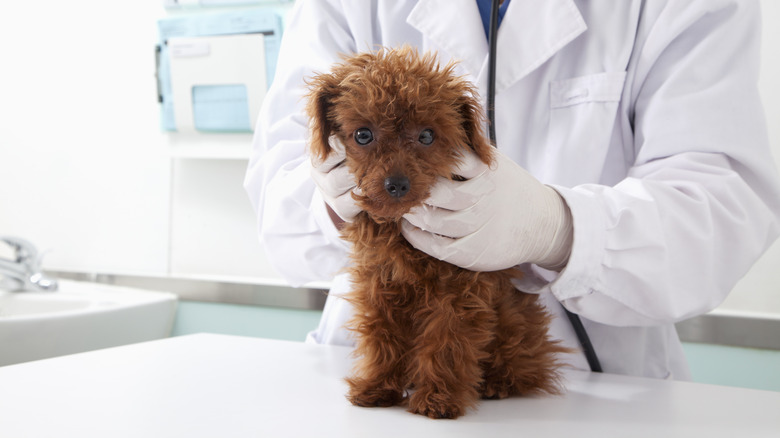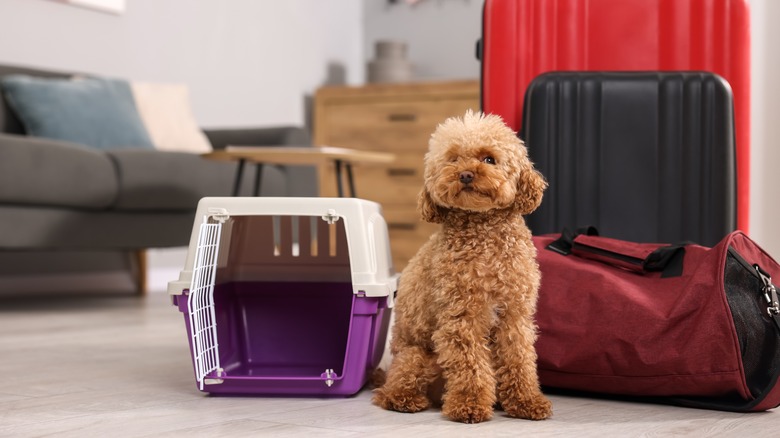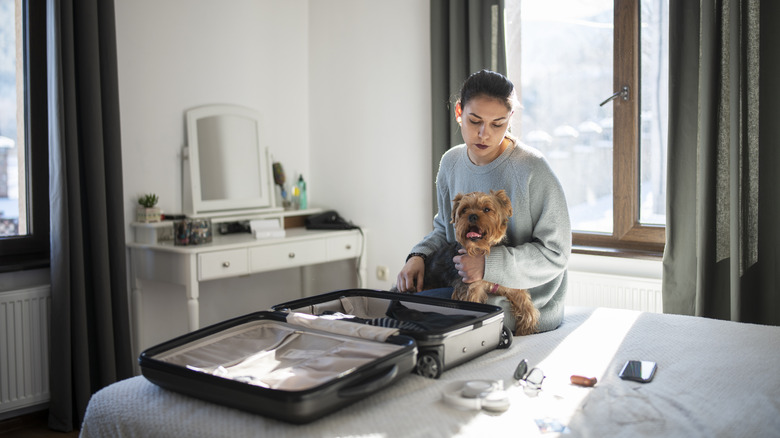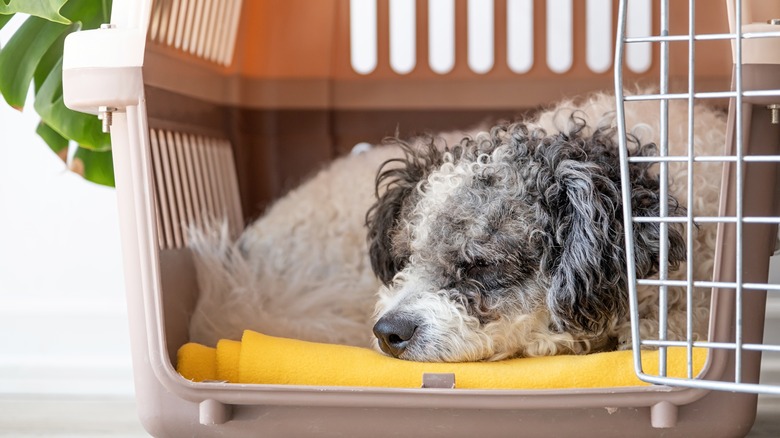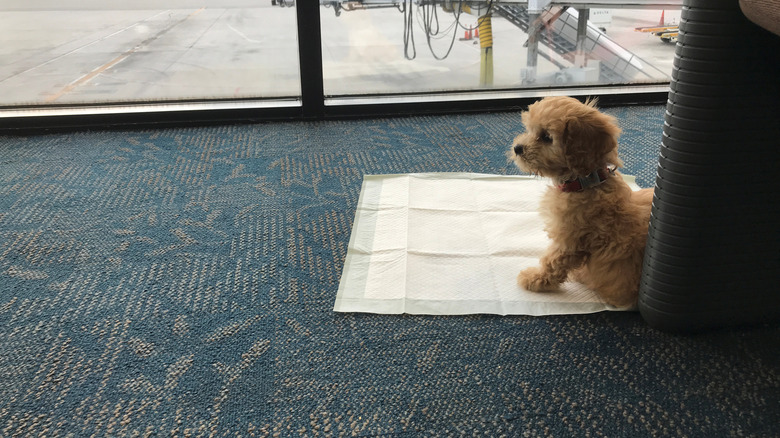Tips For Flying With A Puppy
Maybe you're picking up your new puppy from somewhere far away, or, perhaps you're moving across the country and of course need to bring your young, canine sidekick with you. No matter the reason, flying with a puppy can be stressful — especially if not done properly. Thankfully, there are some steps you can take to make sure the travel day goes smoothly.
One of the best tips for traveling by airplane with a puppy is to simply be prepared before you even get to the airport. There are many necessary steps for flying with a puppy — more than you might even realize — so it's important you have everything in order prior to your flight in order to prevent any stressful situations from arising. With these tips, you will be on your way to a fun and worry-free trip through the air with your precious puppy by your side.
Make sure vaccines are up to date
Before you even book your flight, you are going to want to make sure your puppy's vaccines are up to date. Not only will these vaccines help keep your puppy healthy, but many airlines may require proof of vaccination for your puppy to travel. Depending on if you are flying domestically or internationally, you will want to do your research and see what the travel vaccine and health requirements are for your destination.
If your puppy doesn't have their required vaccines needed to fly, make sure to get them into the vet as soon as possible to get it taken care of before your trip. Also be sure to check with the airline you are flying beforehand to see what their specific health requirements are, beyond just those pertaining to where you're traveling. Some airlines and destinations may require your puppy to have their rabies vaccine, which is typically first administered around 16-18 weeks old, per the American Kennel Club.
Do your research beforehand
Along with checking to make sure your puppy's vaccines are up to date, you are going to want to do your research on any other potential policies your airline may have, along with any health documentation they may require. Similarly, you are going to want to research rules and regulations for flying domestically or internationally, depending on your destination. When flying domestically in the United States, puppies need to be at least eight weeks old, per the U.S. Department of Transportation. When booking a flight, there might be a place to alert the airline that you will be flying with a pet in the cabin, or you might need to call them in order to secure your puppy's spot. You can also call the airline ahead of time to get more details regarding their regulations with puppies in the cabin.
The last thing you want is to get to the airport with your puppy and be turned away because they don't have an acceptable carrier. Different airlines are going to have different rules when it comes to the types of carriers you're allowed to bring, which is why it's important to do your research long before your flight to make sure you get an airline-approved pet carrier. Along with meeting the other requirements of the airline, your puppy's carrier needs to be small enough to fit under your seat.
Pack supplies and come prepared
Another pre-flight step you'll want to take is figuring out what supplies your puppy will need for their adventure, and then getting those packed away in a carry-on bag. Of course you'll want to bring your carrier, and you'll also want to put puppy pads in the carrier in case they have an accident. Be sure to bring extra so you can swap used ones out for a fresh one as needed. You may also want to carry disinfecting wipes, poop bags, and latex gloves to clean up any accidents.
Along with a carrier and pee pads, you'll want to bring the essentials: extra food, dog travel bowls, a leash, and a collar or harness. Make sure your puppy has an identification tag on their collar just in case they happen to get lost or escape their carrier at the airport. You'll also probably want to bring a bone or some sort of chew toy to keep your puppy entertained throughout the travel day.
Get your puppy used to their carrier
One tip that will help reduce both you and your puppy's stress is getting them used to their carrier before your actual flight. You don't want to deal with a barking and crying puppy on a plane, so getting them used to being in their carrier prior to your trip is pivotal. Once you have acquired the approved travel carrier you plan to use, consider putting your puppy in it during naps to have them start getting used to it. Even when you aren't putting them in it, keep access to the carrier open at all times so your puppy can start going in on their own.
When your puppy is spending time in the carrier, reward them with treats so they can start to enjoy it and feel comfortable. When going through security, you are going to have to take your puppy out of their carrier before it goes through x-ray screening. Along with getting them used to the carrier, you should also practice taking your puppy in and out of their carrier a few times before heading to the airport so everyone is prepared for this step.
Avoid feeding them, but do let them go potty beforehand
Before flying with a puppy, you also want to be aware of when you feed them. Typically, it's best to avoid feeding your puppy before your flight. By not feeding them the day of the flight, there's a better chance they won't experience an upset stomach and they are going to be less likely to vomit. However, you should still carry some puppy food with you for after the flight or if you have a long layover. While food is best withheld, don't restrict water from your puppy.
Exercise your puppy before a flight to get their energy out and help them to relax on the plane. Also, be sure they go to the bathroom before getting on board. While many airports have pet relief areas, it's best to avoid these when traveling with a small puppy who isn't fully vaccinated yet. Instead, let them go potty on a pee pad.
